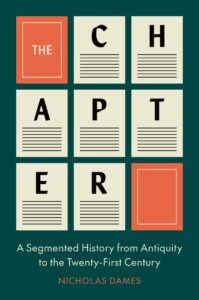Why do books have chapters? By asking this seemingly simple question, my book embarks on a literary journey spanning two millennia, revealing how an ancient editorial technique became a universally recognized component of narrative art and a means to register the sensation of time.
The Chapter begins with the textual compilations of the Roman world, where chapters evolved as a tool to organize information. It goes on to investigate the earliest divisional systems of the Gospels and the segmentation of medieval romances, describing how the chapter took on new purpose when applied to narrative texts and how narrative segmentation gave rise to a host of aesthetic techniques. What follows are in-depth readings of influential figures, from Sterne, Goethe, Tolstoy, and Dickens to George Eliot, Machado de Assis, B. S. Johnson, Agnès Varda, Uwe Johnson, Jennifer Egan, and László Krasznahorkai. The book illuminates the sometimes tacit, sometimes dramatic ways in which the chapter became a kind of reckoning with time and a quiet but persistent feature of modernity.
Ranging from ancient tablets and scrolls to contemporary fiction and film, The Chapter provides a compelling, elegantly written history of a familiar compositional mode that readers often take for granted, and offers a new theory of how this versatile means of dividing narrative sculpts our experience of time.
The Chapter: A Segmented History from Antiquity to the Twenty-First Century is available now from Princeton University Press, Bookshop, and Amazon.
Earlier and partial versions of the book appeared in The New Yorker (‘The Chapter: A History’) and in the 2019 volume Book Parts, edited by Dennis Duncan and Adam Smyth and available here.

